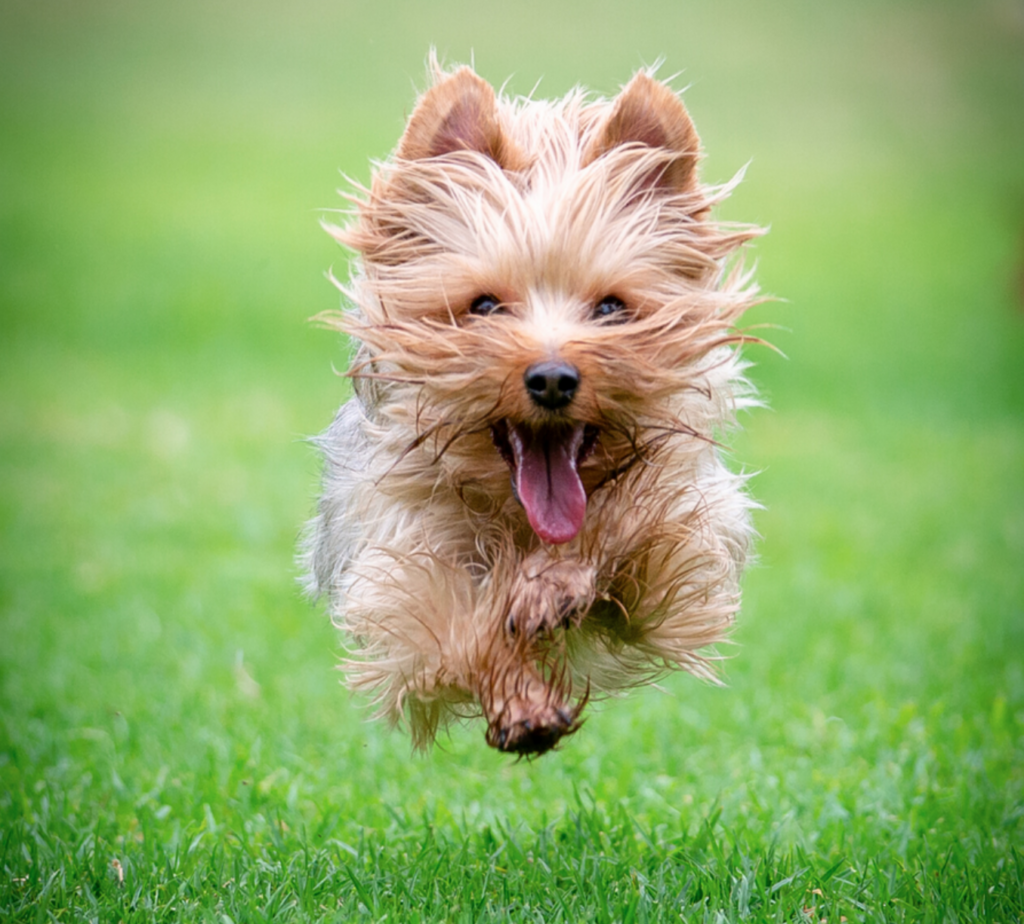Introduction

Ah, zoomies in puppies. Every puppy owner knows the phenomenon of “puppy zoomies” all too well – those sudden bursts of frenetic energy where your puppy seems to go into overdrive, sprinting around the house or yard with abandon. But often owners don’t really know why it happens or what to do about it. While puppy zoomies can be entertaining to watch, they can also be puzzling and even concerning for new dog owners. And rightfully so.

But don’t worry. We’ll explore not only why zoomies happen, but what to do about it from a dog trainer’s perspective.
What Are Puppy Zoomies?
Puppy zoomies, also known as the “zoomies,” “frapping” (a playful combination of “frenetic” and “happy” which I think is very misleading), or the “witching hour,” refer to those sudden bursts of energy and wild behavior exhibited by puppies. During a zoomie episode, your puppy may run around in circles, dart back and forth, leap on and off furniture, and other erratic behaviors. These episodes can last anywhere from a few seconds to several minutes and often occur spontaneously, without any apparent trigger. At least not a trigger you’ve noticed YET.
“Red Zone” Behaviors
In our dog training, we teach owners to watch out for “red zone” behaviors. A puppy goes into the “red zone” when they become out of control and especially struggle to pay any attention to you as the owner. Zoomies definitely classify as “red zone” behavior, but so can other behaviors like when a play session starts to escalate out of control. Other examples of “red zone” could be getting overly nippy, becoming fixated on a toy, going crazy when someone new comes to the door, or excess barking and whining in the crate.
Be aware that allowing your puppy to stay in the “red zone” can then escalate into zoomies. But more specifics on that later.
When Zoomies in Puppies Happen?
Puppy zoomies tend to happen most frequently in young dogs, typically between the ages of a few months to around a year old. However, some older dogs may also experience zoomies, especially if they are particularly energetic or have not been offered enough mental stimulation.
The timing of puppy zoomies can vary from dog to dog, but they often occur in the following situations:

- First Thing in the Morning: Puppies often experience a surge of energy in the morning. This burst of energy may escalate to zoomies if you allow it. I have found that if I try to food train with a puppy’s breakfast right after they’ve gone potty, it’s a total failure. The puppy is too excited, full of new energy, and hungry to think straight.
- During Playtime: Play sessions allowed to stay in the “red zone” can trigger puppy zoomies, especially if the play is particularly vigorous or wild.
- In the Evening: This is a big one! I’ve heard it again and again: “My puppy goes crazy in the evening, right around 7:30 or 8:00pm.” This is often referred to as the “witching hour.” This time of day can be a prime time for zoomies to occur.
- When Overtired: Contrary to popular belief, zoomies are not always a sign of boundless energy. In many cases, puppies may experience zoomies because they are overtired.
- When Overstimulated: Puppies are naturally curious and easily excitable, and they can become overstimulated by new experiences, environments, or interactions. Overstimulation can trigger zoomies in puppies.
Why Do Puppies Get Zoomies?
Getting to the root cause of WHY zoomies occur can help owners manage and address it. Let’s look at the “why” of zoomies using each of the common situations we described above.
- First Thing in the Morning: Puppies definitely need to get out to potty first thing in the morning and then are super excited for breakfast (that is, if you’ve done your crate and potty training right). Your puppy just got a good night’s sleep (hopefully) and is full of energy for a new day. All this can add up to a puppy that is very likely to jump into the “red zone” and easily into zoomies if we allow it.
- During Playtime: Playtime can escalate to zoomies if we allow puppies to hang out in the “red zone” of behaviors while playing.
- In the Evening: Just like babies, evening zoomies can be a sign that your puppy is overtired. I talk more about this in this blog. Also, if they haven’t had any physical outlet all day it may be their body trying to get all the pent-up energy out so they can settle for sleep. But it is more likely that your puppy is just overtired.
- When Overtired: Puppies need to rest and sleep a LOT. Like I’m talking upwards of 20 hours a day! Jason and I often say: If your puppy is WIRED, perhaps they’re TIRED. Research shows when a human baby is overtired, their body releases a stress hormone in order to stay awake. (As described in a previous blog).
I saw it in our own 18-month-old baby, John, just last night. It was 9:00pm, an hour past his bedtime, and he was wired. He was uncharacteristically jumping all over the couch, running in circles, and banging into things. He was laughing hysterically one minute and crying the next. Although it was kind of cute, the poor kid was wired because he was tired. He had that stress hormone pumping through his veins, giving him a crazy “second wind.” I believe a similar thing may happen to puppies. - When Overstimulated: When not given any direction or help to know what to focus on, the puppy’s mind can start to run wild when presented with new experiences, environments or interactions. Zoomies may be a physical expression of what is happening mentally: overstimulation and a mind that can’t focus.
What to Do About Zoomies in Puppies
While puppy zoomies are a normal and often amusing behavior, it’s essential to manage them appropriately. With an ultimate goal of having a calm and healthy state of mind, your puppy getting the zoomies isn’t doing you OR your puppy any favors. Here are some tips for handling puppy zoomies effectively:
- First Thing in the Morning: Like I said earlier, I don’t have a lot of luck getting a puppy to focus or train first thing in the morning. Instead, take your puppy out to potty on leash and just get the job done as calmly and quickly as possible. Then have the puppy go right back in their crate. With the crate door open, take a handful of food to feed them from your hand. Don’t feed all of their breakfast, but just enough to help them not be so voracious. Close the crate and take a break for 15 minutes or so. Come back and give another quick potty break. At that point you will likely have a puppy much more ready to focus and work.
See? By being aware and managing the situation, we don’t even allow the situation to get to the “zoomie zone”. - Don’t Allow Playtime to Escalate: Remember that young puppies need a lot of rest and downtime. So the first thing to remember is that playtime can be short and simple. Even 5-10 minutes is great. No fancy toys required. Then watch for “red zone” behaviors and nip them in the bud. Call your puppy back to you so they have to disengage from play and calm a bit before playing again. Alternatively, you can stop the playtime altogether to have some downtime in the crate.
- Evening Routine: Puppies need a lot of sleep! (Have I said it enough yet?) Start having a predictable, short, and calming evening routine to get your puppy ready for bed. Then consider getting your puppy to be regularly by 7:30 or 8:00pm. For even more detailed and exact directions on a positive puppy routine, check out our Crate and Potty Training Course.
- Recognize Signs of Overtiredness: Pay attention to your puppy’s body language and behavior to identify signs of overtiredness. Remember, hyperactivity can be a sign of your puppy being overtired. Consider it may be time to provide a quiet, calm environment for rest and relaxation. The crate is a wonderful option! Check out our Crate and Potty Training Course for exactly how.
- Avoid Overstimulation: In training puppies, we are careful how much stimulation a puppy gets. Yes, you want to socialize your puppy to as many things as possible: sounds, touch, other people, other dogs, and even different textures of flooring. But be careful that your puppy is able to maintain some semblance of focus and a calm state of mind. That’s where the real magic happens!
We get it; you’re working with a puppy here and may only get their focus for a few seconds at a time. But it’s a real problem if you can’t get their focus at all because they are overstimulated. It’s just too much. That’s when we know it’s time to pull back and take away some of the stimulants. In our puppy training course, we call socialization “composure training” because we’re specifically working for calm and composure while we’re introducing new things. We teach you exactly how to do composure training in our puppy training course.
Avoid Reinforcing Zoomies:
While it may be tempting to join in the fun during a zoomie episode, be careful not to inadvertently reinforce this behavior. Just like we explained in this blog, you get what you pet. You also get more of behaviors you engage in. Avoid chasing or encouraging your puppy during zoomies, as this could lead to an increase in frequency or intensity over time. Try using the techniques I described above instead.
Conclusion
Puppy zoomies are a natural and often entertaining behavior in puppies, but they can also be a sign of underlying needs or imbalances. By understanding the triggers behind puppy zoomies and using proper training techniques, you can help ensure that your puppy remains happy, healthy, and well-adjusted. Remember to prioritize rest for your puppy and adequate mental stimulation (training is the #1 way to get good mental stimulation).
Want more step by step guidance on how to train your puppy? Check out our Puppy Training Course. It has everything you need to successfully navigate those puppy months to lay a great foundation for life!
+ show Comments
- Hide Comments
add a comment